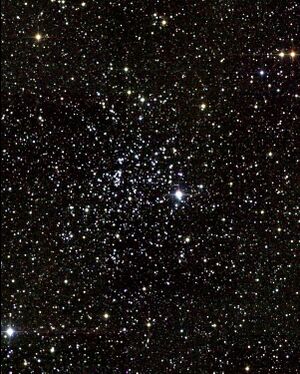Messier 52
Topic: Astronomy
 From HandWiki - Reading time: 3 min
From HandWiki - Reading time: 3 min
| Messier 52 | |
|---|---|
 Open cluster Messier 52 in Cassiopeia | |
| Observation data (J2000 epoch) | |
| Constellation | Cassiopeia |
| Right ascension | 23h 24m 48.0s[1] |
| Declination | +61° 35′ 36″[1] |
| Distance | 4.6 kly (1.4 kpc)[1] |
| Apparent magnitude (V) | 7.3[2] |
| Apparent dimensions (V) | 13.0′[3] |
| Physical characteristics | |
| Mass | 1,200 M☉[4] M☉ |
| Radius | 9.5 ly[3] |
| Estimated age | 158.5 Myr[1] |
| Other designations | NGC 7654, Cr 455, C 2322+613, OCl 260[5] |
Messier 52 or M52, also known as NGC 7654, is an open cluster of stars in the highly northern constellation of Cassiopeia. It was discovered by Charles Messier in 1774.[3][lower-alpha 1] It can be seen from Earth under a good night sky with binoculars. The brightness of the cluster is influenced by extinction, which is stronger in the southern half.[6] Its metallicity is somewhat below that of the Sun, and is estimated to be [Fe/H] = −0.05 ± 0.01.[7]
R. J. Trumpler classified the cluster appearance as II2r, indicating a rich cluster with little central concentration and a medium range in the brightness of the stars.[8] This was later revised to I2r, denoting a dense core.[6] The cluster has a core radius of 2.97 ± 0.46 ly (0.91 ± 0.14 pc) and a tidal radius of 42.7 ± 7.2 ly (13.1 ± 2.2 pc).[4] It has an estimated age of 158.5 million years[1] and a mass of 1,200 M☉.[4]
The magnitude 8.3 supergiant star BD +60°2532 is a probable member of the cluster,[4] so too 18 candidate slowly pulsating B stars, one being a Delta (δ) Scuti variable, and three candidate Gamma Doradus (γ Dor) variables.[9] There may also be three Be stars.[10] The core of the cluster shows a lack of interstellar matter, which may be due to supernovae explosion(s) early in the cluster's history.[6]
See also
References and footnotes
- ↑ 1.0 1.1 1.2 1.3 1.4 Wu, Zhen-Yu et al. (November 2009), "The orbits of open clusters in the Galaxy", Monthly Notices of the Royal Astronomical Society 399 (4): 2146–2164, doi:10.1111/j.1365-2966.2009.15416.x, Bibcode: 2009MNRAS.399.2146W.
- ↑ "Messier 52". https://messier.seds.org/m/m052.html.
- ↑ 3.0 3.1 3.2 Adam, Len (2018), Imaging the Messier Objects Remotely from Your Laptop, The Patrick Moore Practical Astronomy Series, Springer, p. 241, ISBN 978-3319653853, Bibcode: 2018imor.book.....A, https://books.google.com/books?id=7nNUDwAAQBAJ&pg=PA241
- ↑ 4.0 4.1 4.2 4.3 Bonatto, C.; Bica, E. (September 2006), "Methods for improving open cluster fundamental parameters applied to M 52 and NGC 3960", Astronomy and Astrophysics 455 (3): 931–942, doi:10.1051/0004-6361:20065315, Bibcode: 2006A&A...455..931B
- ↑ "M 52". SIMBAD. Centre de données astronomiques de Strasbourg. http://simbad.u-strasbg.fr/simbad/sim-basic?Ident=M+52.
- ↑ 6.0 6.1 6.2 Pandey, A. K. et al. (August 2001), "NGC 7654: An interesting cluster to study star formation history", Astronomy and Astrophysics 374 (2): 504–522, doi:10.1051/0004-6361:20010642, Bibcode: 2001A&A...374..504P.
- ↑ Akbulut, B.; Ak, S.; Yontan, T.; Bilir, S.; Ak, T.; Banks, T.; Kaan Ulgen, E.; Paunzen, E. (2021). "A study of the Czernik 2 and NGC 7654 open clusters using CCD UBV photometric and Gaia EDR3 data". Astrophysics and Space Science 366 (7). doi:10.1007/s10509-021-03975-x.
- ↑ Trumpler, Robert Julius (1930), "Preliminary results on the distances, dimensions and space distribution of open star clusters", Lick Observatory Bulletin 420: 154–188, doi:10.5479/ADS/bib/1930LicOB.14.154T, Bibcode: 1930LicOB..14..154T.
- ↑ Luo, Y. P. et al. (February 2012), "Discovery of 14 New Slowly Pulsating B Stars in the Open Cluster NGC 7654", The Astrophysical Journal Letters 746 (1): 5, doi:10.1088/2041-8205/746/1/L7, L7, Bibcode: 2012ApJ...746L...7L.
- ↑ Bond, Howard E. (August 1973), "Be Stars in the Galactic Cluster M 52", Publications of the Astronomical Society of the Pacific 85 (506): 405, doi:10.1086/129477, Bibcode: 1973PASP...85..405B.
- ↑ September 7
External links
- Messier 52, SEDS Messier pages
- Messier 52 on WikiSky: DSS2, SDSS, GALEX, IRAS, Hydrogen α, X-Ray, Astrophoto, Sky Map, Articles and images
Coordinates: ![]() 23h 24.2m 00s, +61° 35′ 00″
23h 24.2m 00s, +61° 35′ 00″
 |
 KSF
KSF
